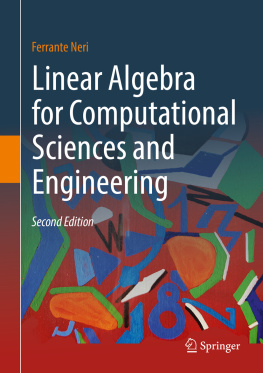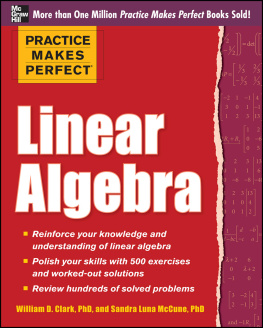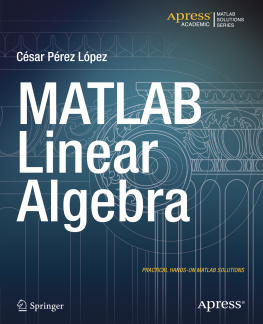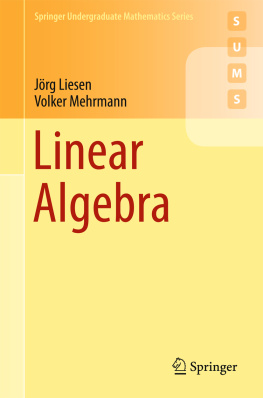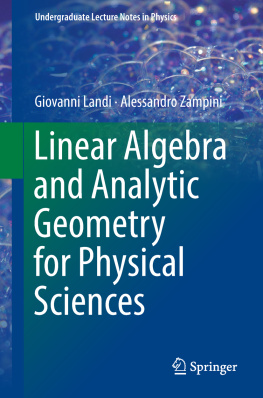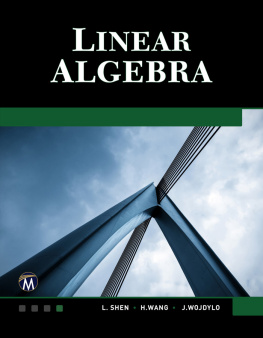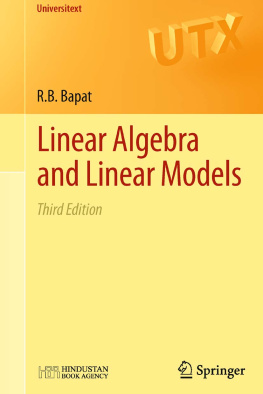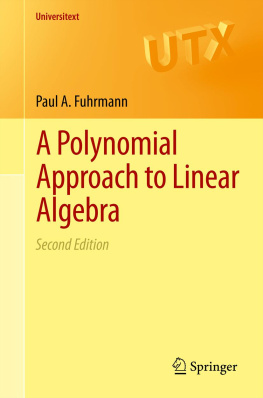Ferrante Neri - Linear Algebra for Computational Sciences and Engineering
Here you can read online Ferrante Neri - Linear Algebra for Computational Sciences and Engineering full text of the book (entire story) in english for free. Download pdf and epub, get meaning, cover and reviews about this ebook. year: 2019, publisher: Springer International Publishing, genre: Children. Description of the work, (preface) as well as reviews are available. Best literature library LitArk.com created for fans of good reading and offers a wide selection of genres:
Romance novel
Science fiction
Adventure
Detective
Science
History
Home and family
Prose
Art
Politics
Computer
Non-fiction
Religion
Business
Children
Humor
Choose a favorite category and find really read worthwhile books. Enjoy immersion in the world of imagination, feel the emotions of the characters or learn something new for yourself, make an fascinating discovery.
- Book:Linear Algebra for Computational Sciences and Engineering
- Author:
- Publisher:Springer International Publishing
- Genre:
- Year:2019
- Rating:3 / 5
- Favourites:Add to favourites
- Your mark:
- 60
- 1
- 2
- 3
- 4
- 5
Linear Algebra for Computational Sciences and Engineering: summary, description and annotation
We offer to read an annotation, description, summary or preface (depends on what the author of the book "Linear Algebra for Computational Sciences and Engineering" wrote himself). If you haven't found the necessary information about the book — write in the comments, we will try to find it.
Ferrante Neri: author's other books
Who wrote Linear Algebra for Computational Sciences and Engineering? Find out the surname, the name of the author of the book and a list of all author's works by series.
Linear Algebra for Computational Sciences and Engineering — read online for free the complete book (whole text) full work
Below is the text of the book, divided by pages. System saving the place of the last page read, allows you to conveniently read the book "Linear Algebra for Computational Sciences and Engineering" online for free, without having to search again every time where you left off. Put a bookmark, and you can go to the page where you finished reading at any time.
Font size:
Interval:
Bookmark:
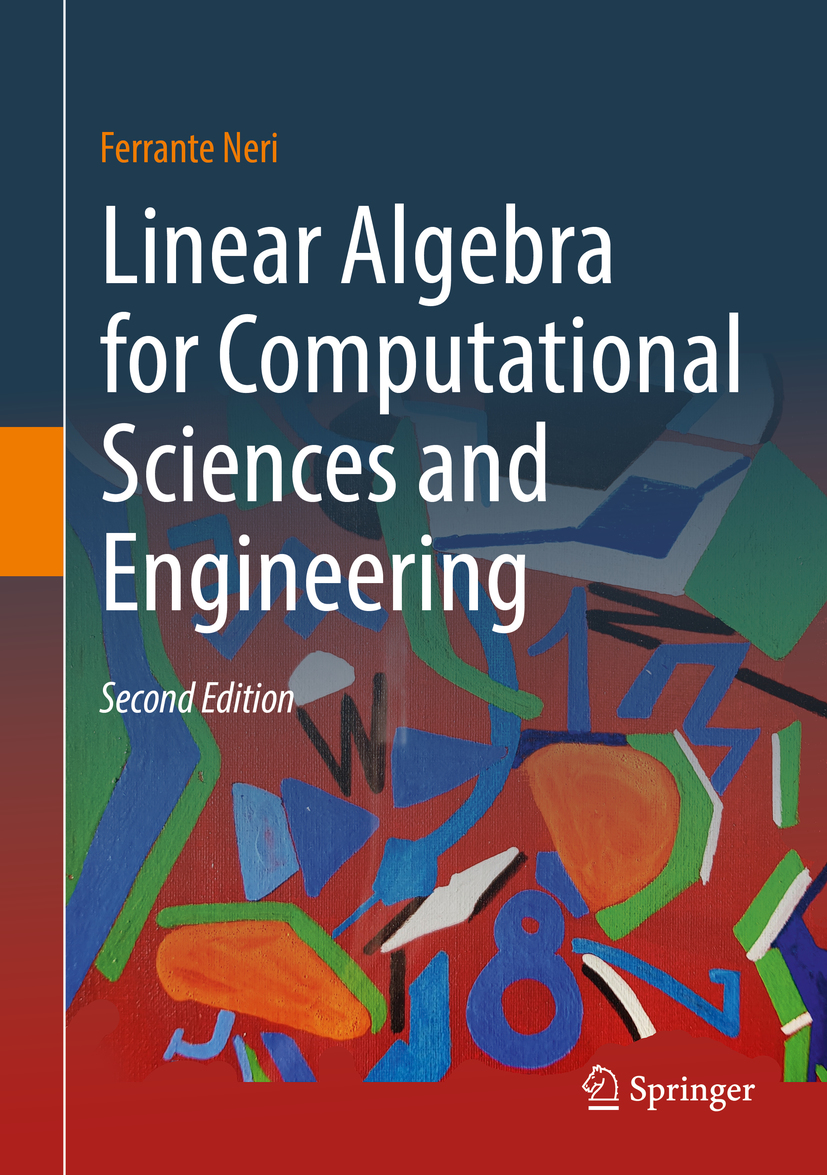

This Springer imprint is published by the registered company Springer Nature Switzerland AG.
The registered company address is: Gewerbestrasse 11, 6330 Cham, Switzerland
- .
Happiness is to be understood.
( )
Georgi Polonsky
(Well Live Till Monday)
The history of linear algebra can be viewed within the context of two important traditions.
The first tradition (within the history of mathematics) consists of the progressive broadening of the concept of number so to include not only positive integers but also negative numbers, fractions and algebraic and transcendental irrationals. Moreover, the symbols in the equations became matrices, polynomials, sets and, permutations. Complex numbers and vector analysis belong to this tradition. Within the development of mathematics, the one was concerned not so much about solving specific equations but mostly about addressing general and fundamental questions. The latter were approached by extending the operations and the properties of sum and multiplication from integers to other linear algebraic structures. Different algebraic structures (lattices and Boolean algebra) generalized other kinds of operations, thus allowing to optimize some non-linear mathematical problems. As a first example, lattices were generalizations of order relations on algebraic spaces, such as set inclusion in set theory and inequality in the familiar number systems (  ,
,  ,
,  , and
, and  ). As a second example, Boolean algebra generalized the operations of intersection and union and the principle of duality (De Morgans relations), already valid in set theory, to formalize the logic and the propositions calculus. This approach to logic as an algebraic structure was much similar as the Descartes algebra approach to the geometry. Set theory and logic have been further advanced in the past centuries. In particular, Hilbert attempted to build up mathematics by using symbolic logic in a way that could prove its consistency. On the other hand, Gdel proved that in any mathematical system, there will always be statements that can never be proven either true or false.
). As a second example, Boolean algebra generalized the operations of intersection and union and the principle of duality (De Morgans relations), already valid in set theory, to formalize the logic and the propositions calculus. This approach to logic as an algebraic structure was much similar as the Descartes algebra approach to the geometry. Set theory and logic have been further advanced in the past centuries. In particular, Hilbert attempted to build up mathematics by using symbolic logic in a way that could prove its consistency. On the other hand, Gdel proved that in any mathematical system, there will always be statements that can never be proven either true or false.
The second tradition (within the history of physical science) consists of the search for mathematical entities and operations that represent aspects of the physical reality. This tradition played a role in the Greek geometrys bearing and its following application to physical problems. When observing the space around us, we always suppose the existence of a reference frame, identified with an ideal rigid body, in the part of the universe in which the system we want to study evolves (e.g. a three axes system having the sun as their origin and direct versus three fixed stars). This is modelled in the so-called Euclidean affine space. A reference frames choice is purely descriptive at a purely kinematic level. Two reference frames have to be intuitively considered distinct if the correspondent rigid bodies are in relative motion. Therefore, it is important to fix the links ( linear transformations ) between the kinematic entities associated with the same motion but relatives to two different reference frames ( Galileos relativity ).
In the seventeenth and eighteenth centuries, some physical entities needed a new representation. This necessity made the above-mentioned two traditions converge by adding quantities as velocity, force, momentum and acceleration ( vectors ) to the traditional quantities as mass and time ( scalars ). Important ideas led to the vectors major systems: the forces parallelogram concept by Galileo, the situations geometry and calculus concepts by Leibniz and by Newton and the complex numbers geometrical representation. Kinematics studies the motion of bodies in space and in time independently on the causes which provoke it. In classical physics, the role of time is reduced to that of a parametric independent variable. It needs also to choose a model for the body (or bodies) whose motion one wants to study. The fundamental and simpler model is that of point (useful only if the bodys extension is smaller than the extension of its motion and of the other important physical quantities considered in a particular problem). The motion of a point is represented by a curve in the tridimensional Euclidean affine space. A second fundamental model is the rigid body one, adopted for those extended bodies whose component particles do not change mutual distances during the motion.
Later developments in electricity, magnetism and optics further promoted the use of vectors in mathematical physics. The nineteenth century marked the development of vector space methods, whose prototypes were the three-dimensional geometric extensive algebra by Grassmann and the algebra of quaternions by Hamilton to, respectively, represent the orientation and rotation of a body in three dimensions. Thus, it was already clear how a simple algebra should meet the needs of the physicists in order to efficiently describe objects in space and in time (in particular their dynamical symmetries and the corresponding conservation laws) and the properties of space-time itself. Furthermore, the principal characteristic of a simple algebra had to be its linearity (or at most its multi-linearity). During the latter part of the nineteenth century, Gibbs based his three-dimensional vector algebra on some ideas by Grassmann and by Hamilton, while Clifford united these systems into a single geometric algebra (direct product of quaternions algebras). Afterwards, the Einsteins description of the four-dimensional continuum space-time (special and general relativity theories) required a tensor algebra. In the 1930s, Pauli and Dirac introduced Clifford algebras matrix representations for physical reasons: Pauli for describing the electron spin while Dirac for accommodating both the electron spin and the special relativity.
Font size:
Interval:
Bookmark:
Similar books «Linear Algebra for Computational Sciences and Engineering»
Look at similar books to Linear Algebra for Computational Sciences and Engineering. We have selected literature similar in name and meaning in the hope of providing readers with more options to find new, interesting, not yet read works.
Discussion, reviews of the book Linear Algebra for Computational Sciences and Engineering and just readers' own opinions. Leave your comments, write what you think about the work, its meaning or the main characters. Specify what exactly you liked and what you didn't like, and why you think so.

